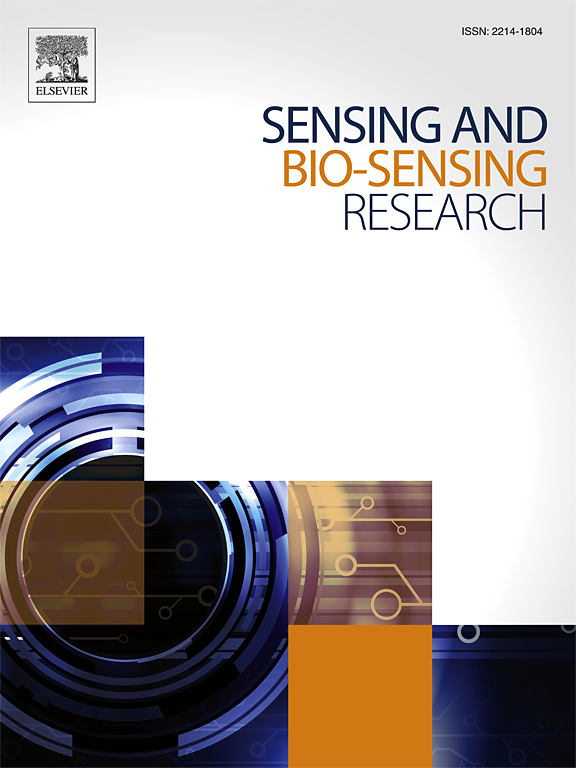基于新型亮蓝-金 NCs 的超灵敏无标记比率比色传感器,用于检测自来水中的游离氯
IF 4.9
Q1 CHEMISTRY, ANALYTICAL
引用次数: 0
摘要
本研究在合成着色剂亮蓝的引导下制备了金纳米团簇(BB-Au NCs)。透射电子显微镜(TEM)和 X 射线光电子能谱(XPS)对制备产物的微观结构和晶体结构进行了表征。游离氯是一种不可避免且无处不在的消毒副产物,它增强了 BB-Au NCs 在 247 纳米波长处的吸光度,同时降低了其在 308 和 630 纳米波长处的吸光度。利用基于密度泛函理论(DFT)的计算化学方法分析了 BB-Au NCs 的光学特性和游离氯的影响。利用 BB-Au NCs 在 247 纳米波长和 630 纳米波长处的吸光度比值,对 5 至 50 μM 范围内的游离氯进行了精确的定量测定,检测限为 1 μM。该方法可用于水样中游离氯的简单而环保的检测。本文章由计算机程序翻译,如有差异,请以英文原文为准。
Ultrasensitive label-free ratiometric colorimetric sensor for free chlorine detection in tap water based on a novel brilliant blue-Au NCs
In this work, Au nanoclusters was prepared under the guidance of a synthetic colorant brilliant blue (BB-Au NCs). The microstructure and crystal structure of the resulting products were characterized by transmission electron microscopy (TEM) and X-ray photoelectron spectroscopy (XPS). The absorbance of BB-Au NCs at 247 nm was enhanced while the absorbance at 308 and 630 nm was reduced by free chlorine, an unavoidable and ubiquitous disinfection byproduct. The optical properties of BB-Au NCs and the influence of free chlorine were analyzed using computational chemistry methods based on density functional theory (DFT). The ratio of absorbance of BB-Au NCs at 247 and 630 nm was used for accurate quantitative determination of free chlorine in a range from 5 to 50 μM, with the detection limit is 1 μM. This method demonstrates potential application for simple and environmentally friendly detection of free chlorine in water samples.
求助全文
通过发布文献求助,成功后即可免费获取论文全文。
去求助
来源期刊

Sensing and Bio-Sensing Research
Engineering-Electrical and Electronic Engineering
CiteScore
10.70
自引率
3.80%
发文量
68
审稿时长
87 days
期刊介绍:
Sensing and Bio-Sensing Research is an open access journal dedicated to the research, design, development, and application of bio-sensing and sensing technologies. The editors will accept research papers, reviews, field trials, and validation studies that are of significant relevance. These submissions should describe new concepts, enhance understanding of the field, or offer insights into the practical application, manufacturing, and commercialization of bio-sensing and sensing technologies.
The journal covers a wide range of topics, including sensing principles and mechanisms, new materials development for transducers and recognition components, fabrication technology, and various types of sensors such as optical, electrochemical, mass-sensitive, gas, biosensors, and more. It also includes environmental, process control, and biomedical applications, signal processing, chemometrics, optoelectronic, mechanical, thermal, and magnetic sensors, as well as interface electronics. Additionally, it covers sensor systems and applications, µTAS (Micro Total Analysis Systems), development of solid-state devices for transducing physical signals, and analytical devices incorporating biological materials.
 求助内容:
求助内容: 应助结果提醒方式:
应助结果提醒方式:


